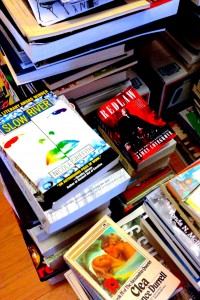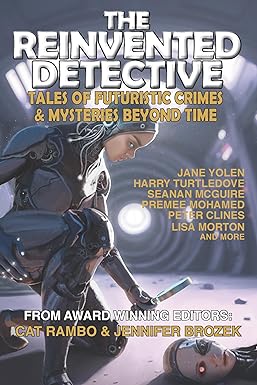 In reading for Women Destroy Fantasy, I’ve cleared about two hundred stories away so far, and there’s still about a hundred I have yet to read. Some amazing stuff, some familiar names, and all in all, a slush pile that is full enough of solid stories that I could fill several issues. It’s been a great pleasure to be elbow deep in so much excellence. So here’s a few notes on the experience so far.
In reading for Women Destroy Fantasy, I’ve cleared about two hundred stories away so far, and there’s still about a hundred I have yet to read. Some amazing stuff, some familiar names, and all in all, a slush pile that is full enough of solid stories that I could fill several issues. It’s been a great pleasure to be elbow deep in so much excellence. So here’s a few notes on the experience so far.
In my head, I have these slots:
- My fairytale/legend/historical slot: Right now there’s a very good historical piece that I’ve tentatively penciled in here. It hits a lot of my sweet spots as a reader, it’s an interesting magic system, and it’s a good story. We’ll see if anything comes along that knocks it out of that slot.
- My steampunk/Victorian slot: Plenty of these stories to choose from, and again there’s a particular one in the lead.
- My superhero slot: A good number of these, and they are all jostling for the slot. I don’t have a favorite yet.
- My urban/modern day fantasy slot: Another one with multiple contenders so far, and there’s a number of wild and weird ones.
My criteria? I want good stories that will stick in the reader’s head and keep them thinking long after they’re done reading. I want lovely prose — but not so lovely that it eclipses the story. I want heart — I’m still looking for a story in the pile that makes me cry.
Other observations:
- It’s a good idea to think about the impetus behind the anthology. Things like an anti-feminist message are probably going to be an awfully hard sell for an issue with what I’d consider a feminist theme.
- Lots of wings in this slushpile. Not saying that’s bad, but man are there a lot of stories with this focus.
- A lot has been done with fairytales in the past. Looking for fresher ground might be more rewarding.




 I just finished the first pass on the slushpile for If This Goes On. The anthology is intended to be half solicited manuscripts; half from the open call, and I’m happy to say that I don’t think it’s going to be hard to pull that together. I’ve got five or six definites on my list right now, and I’m setting them aside. I did read through every story except for a handful of less-than-serious ones; thank you to the slushreaders and publisher Colin Coyle for winnowing those out.
I just finished the first pass on the slushpile for If This Goes On. The anthology is intended to be half solicited manuscripts; half from the open call, and I’m happy to say that I don’t think it’s going to be hard to pull that together. I’ve got five or six definites on my list right now, and I’m setting them aside. I did read through every story except for a handful of less-than-serious ones; thank you to the slushreaders and publisher Colin Coyle for winnowing those out. The evolution of crime, punishment, and justice in the future.
The evolution of crime, punishment, and justice in the future.
4 Responses
I’ve heard other anthologists in the past talk about organizing in this fashion–x number of stories in each of several categories–and it almost always sets off my personal justice alarm. Your comment about the urban fantasy slot set it off again. So, in the urban/contemporary fantasy realm, you have several contenders, and it sounds like you even have a good range of stories (“a number of wild and weird ones”). So, what happens if you have a slot you’d to fill with a steampunk story, but the steampunks you have left are all just mediocre compared to the cluster of urban tales. Do you pass on brilliance in order to fill a category?
I realize my rhetoric in that first ‘graph is a bit slanted–perhaps even hyperbolic–but seriously, what are your determining factors? I understand that, having advertised that you would cover a range of subgenres, you are obligated to include at least one story in each subgenre you’ve advertised, but I didn’t get the impression you were publishing only one story in each subgenre. So what are the governing rules? If you have set aside four slots for steampunk/Victorian do you fill all four slots with that subgenre, regardless of individual story quality? Even if all the stories in that category are–say–sixes (on a 1 to 11 scale–we always have to go to eleven) and you have a surfeit of diverse nines in another category?
I’m sure you have a system to cover all these contingencies, Cat. I’m just curious how it works. Thanks.
Hi Dennis –
That’s a great question. Fortunately for me, it’s not a case of passing on brilliance in order to fill a quota. There’s a ton of good stuff in every category and those categories are also entirely self-imposed and somewhat malleable. I’d like to have a good urban fantasy, for example, but if I haven’t hit one with enough wow to it, I’ll use something else.
At the same time, even if I had four great steampunk stories, I’d still be picking just one, because I’m thinking of the issue itself as an entity, and part of its identity is showing a range of fantasy, not just one genre. Part of the trick of editing is that you’re thinking along the lines of creating a whole that is greater than the sum of the parts, using stories that inform or speak to each other. And that requires stories that differ from each other in various ways.
This is the sad thing about being an editor. Sometimes — perhaps even often — you can love a story and not be able to use it. I hit a story yesterday in the slush that I knew wouldn’t work — but I read it all the way through because it was a great story. But it’s not right for this issue.
All in all, though, this is something that is true of rejections; often they are not about a story’s quality. They may be due to the fact that the publication recently ran a similar story or even that the story doesn’t quite match the editor’s sense of their magazine. That’s one reason I suggest writers spend a stint reading slush, so they get a feel for it.
Interesting and scary comments! (As a writer, trying to see if your story 1: falls into any of the above categories, 2: has legs enough to overcome competition.)
On a weird side note: I always thought Steampunk was more sci-fi with the technology? I’m not a steampunk reader, though, so if there are fantasy elements there, I’m interested to see them in play.
What about straight up high fantasy? Home-grown world, medieval/ancient world/eastern faux world? Or would that be considered “historical fantasy?”
Cat, I think it would be worthwhile to write a blog post about your experience in reading for WDSF versus reading for Fantasy in general. I’m curious if an all-female slush pile “feels” different or if there are themes that simply disappeared from the slush and thus seem to be only broached by men. That kind of thing. Just an idea!